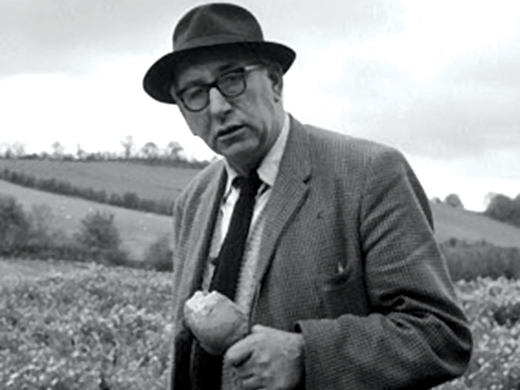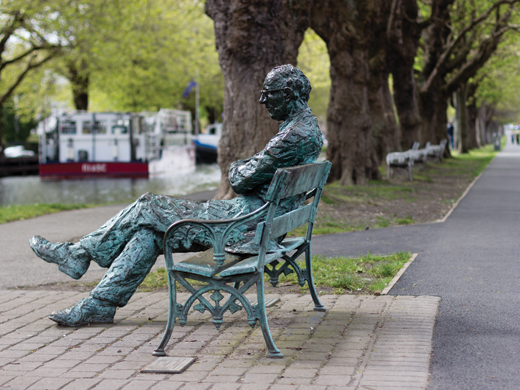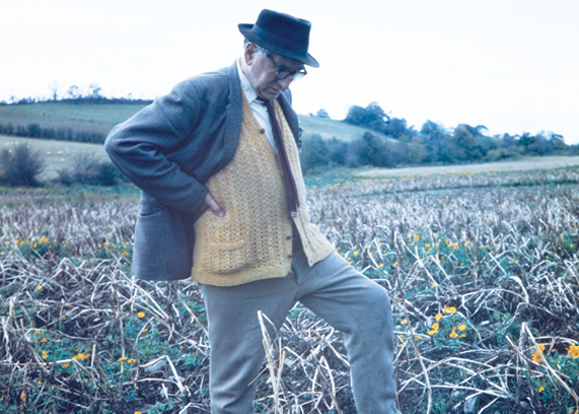Sean Kelly remembers one of Ireland’s most significant and revered poets.
Ireland, from 1932 until 1973, was ruled by the eminently austere statesman Eamon de Valera, in cahoots with John Charles McQuaid, the outstandingly chaste Archbishop of Dublin. The former dreamed of “athletic youths, sturdy children and happy maidens, living the life that God desires that men should live.” The latter issued a ban on tampons, expressing concern that they “could harmfully stimulate young girls at an impressionable age.”
At the time, Seán Ó Faoláin called his homeland, “unimaginative, commonplace and circumscribed… a dreary Eden.” Seán’s good friend, the writer Honor Tracy, described it as “a sparsely populated land where only the pious and the unhinged assemble in any numbers.”
Against that damp, dismal theocracy, “that Green density of gombeen men, crawling hack, bogus patriot and pietistic profiteer” [*] there were, of course, rebels, preeminently Brendan Behan and Patrick Kavanagh. Unfortunately, they hated each other.

Behan was a Dubliner, born and bred, but Kavanagh was born in the back of beyond – on a small farm in the townland of Mucker, the parish of Inniskeen, in Co. Monaghan. Inexplicably, as a teenager he began to write poems. In 1929 he submitted a few to the Irish Statesman, a Dublin literary periodical edited by George Russell, who rejected them but encouraged him to keep writing. After Russell published some poems in 1929 and 1930, Kavanagh walked 50 miles to Dublin to visit him personally, and Russell became his literary patron. Macmillan published his first collection, Ploughman and Other Poems, in 1936, while he was still working “the stony grey soil” of the farm.
“Inniskeen Road: July Evening”
The bicycles go by in twos and threes –
There’s a dance in Billy Brennan’s barn tonight,
And there’s the half-talk code of mysteries
And the wink-and-elbow language of delight.
The following year, he moved to London, where he was commissioned to write his autobiography, a memoir of an idyllic childhood, full of beautiful, charming characters and innocent humor. (In time to come, Kavanagh would bad mouth The Green Fool, as “a stage-Irish lie.”)
In 1939, he returned to Ireland, not to rustic Monaghan but to urban Dublin, and in 1942 published his most celebrated work, the epic poem “The Great Hunger”:
Clay is the word and clay is the flesh
Where the potato-gatherers like mechanized scarecrows move
Along the side-fall of the hill – Maguire and his
men.
The subject of the poem, Patrick Maguire, has lived with his mother until her death at the age of 91. By the time he inherits the farm he is 65, and it’s too late to think of a wife and children – a fate common for Irish eldest sons. Kavanagh’s conclusion is that:
The hungry fiend
Screams the apocalypse of clay
In every corner of this land.
Of course, the poem was repudiated by members of the Literary Renaissance, who had sentimentalized the simple, mythical, mystical peasants of rural Ireland.
In those days, both Behan and Kavanagh did their drinking in McDaid’s, a pub on Harry Street just off Grafton. Behan had already dismissed Kavanagh as a “Culchie,” a “bogman,” and “the fucker from mucker.” Now, upon learning that the sexually frustrated Maguire in the Great Hunger poem occasionally masturbates, Behan took to calling the older poet “Paddy the Wanker.” According to Anthony Cronin in Dead as Door Nails, he “aroused in Kavanagh feelings of loathing and apprehension… phony and blackguard were the words he used oftenest.” Kavanaugh even refused to stand for the National Anthem, on the grounds that it was “a come-all-ye written by Behan’s oul granny.” (It was, in fact, written by Behan’s uncle, Peadar Kearney).
During – and after – the years of the Emergency, as WWII was called in Ireland, the poet made a precarious living as a freelance journalist. He contributed a twice-weekly gossip column to the Irish Press under the pen name “Piers Plowman” and was a book reviewer, staff reporter and film reviewer for the Catholic weekly The Standard. His dream of solving his financial difficulties by marriage to a rich, preferably American, woman eluded him. (Although he always appeared to be utterly destitute, surely Kavanagh’s penury was ameliorated by advances from publishers for books he didn’t write, support from his doctor brother Peter, some revenue from the farm he’d inherited, and occasional funds from – of all people – Archbishop McQuaid.)
In 1944, while he was living in a hovel at 19 Raglan Road, the poet beheld Hilda Moriarty, a medical student just 22 years old and considered one of the most beautiful women in Dublin. The 40-year-old, disheveled, impoverished poet attempted, without success, to woo the maiden. Interviewed on RTÉ in 1987, Hilda told how she abraded him about writing about cabbage and turnips and potatoes. Kavanagh replied that he was a peasant poet. Hilda told him that he should write about something else. The result was a most beautiful poem, – and song:
On Raglan Road on an autumn day I met her first and knew
That her dark hair would weave a snare that I might one day rue;
I saw the danger yet I walked along the enchanted way
And I said let grief be a fallen leaf at the dawning of the day.
Kavanagh had begun writing Tarry Flynn in 1940, under the title Stony Grey Soil. Published in 1948, the novel describes a young farmer’s struggle to rise above the burden of family, Catholicism, farm work and lust, all set in 1930s rural Ireland. The author himself called it, “not only the best but the only authentic account of life as it was lived in Ireland this century.” Of course, the novel was banned and remained out of print until well into the 1960s. Irish authors censored in Ireland were “the best banned in the land,” said Kavanagh’s bête noire Brendan Behan.

After Behan’s prison drama, The Quare Fellow, made its debut in Dublin in 1954, the young playwright was hailed as the next Sean O’Casey. In 1955, after losing a foolish, protracted lawsuit, Kavanagh had a cancerous lung removed. It was the best thing that ever happened to him. “For many a good-looking year, I wrought hard at versing but I would say that, as a poet, I was born in or about nineteen-fifty-five, the place of my birth being the banks of the Grand Canal.” (Self-Portrait, the text of a TV documentary, RTÉ, 1962).
“Canal Bank Walk”
Leafy-with-love banks and the green waters of the canal,
Pouring redemption for me, that I do
The will of God, wallow in the habitual, the
banal,
Grow with nature again as before I grew.
Seamus Heaney described the two parts of Kavanagh’s career as “a heavenly place” and “a placeless heaven.”
Late in life, during the 1967 “Summer of Love,” he and Allen Ginsberg both read at a poetry event in London, where admiring hippies showered Kavanagh with flower petals. That fall, the Abbey Theatre had a major success with their stage version of his novel, Tarry Flynn. While attending the opening performance, he was taken ill and on November 30, died in a Dublin nursing home. He had outlived Behan, his much younger nemesis, by three years. Hilda sent a wreath of roses, shaped as the letter H.
Patrick Kavanagh is commemorated with a bronze sculpture sitting in peaceful solitude on a bench on Mespil Road, beside his beloved Grand Canal. (Dubliners refer the installation as “the crank on the bank.”) A statue of Behan sits likewise near water – on Upper Dorset Street, beside the Royal Canal, where he once heard the old triangle go jingle-jangle. ♦
[*] John Ryan, Remembering How We Stood.


Nice article, good quotes. There is something rather fine about K. As for Behan, what a disgrace.
Aah…but the land of mists has raised many a poet and many a glass
O commemorate me where there is water,
Canal water, preferably, so stilly
Greeny at the heart of summer.
[…]
O commemorate me with no hero-courageous
Tomb – just a canal-bank seat for the passer-by.
– Patrick Kavanagh
https://www.tcd.ie/English/patrickkavanagh/lineswrittenonaseat.html
This is my introduction to the poet Patrick Kavanagh. I listened to his song and felt the tragedy of his life, and though the song is melancholy, it is truly beautiful.